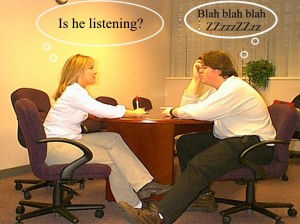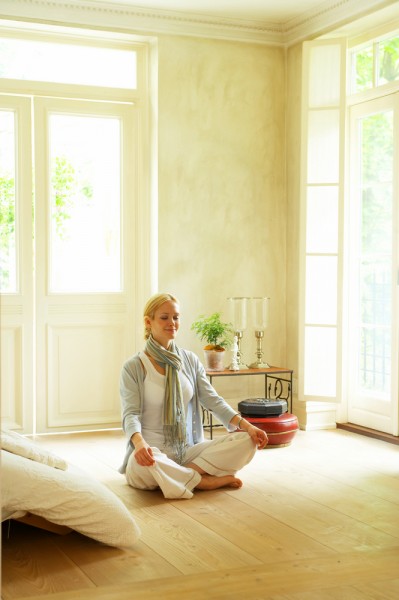 One day I called up my friend, Susan, and asked her how she was. She said, “Things are great. Joe and I just got back from another week long vacation.” I realized that, just about every time I talked to Susan, she had recently gone on vacation. I was a bit annoyed and jealous. “How do you take so many vacations?” I asked. Her reply made me even more annoyed, “We simply make it a priority.” I felt a certain amount of self-pity as I shot back, “Boy, I wish my life was set up so I could take so much time off.” In a compassionate, yet direct manner, Susan replied, “You can if it’s important enough to you. Joe and I just decided we’d take eight weeks off each year. There’s a lot of resistance to doing that, but we’re committed to living the life that we want to live.” Continue reading →
One day I called up my friend, Susan, and asked her how she was. She said, “Things are great. Joe and I just got back from another week long vacation.” I realized that, just about every time I talked to Susan, she had recently gone on vacation. I was a bit annoyed and jealous. “How do you take so many vacations?” I asked. Her reply made me even more annoyed, “We simply make it a priority.” I felt a certain amount of self-pity as I shot back, “Boy, I wish my life was set up so I could take so much time off.” In a compassionate, yet direct manner, Susan replied, “You can if it’s important enough to you. Joe and I just decided we’d take eight weeks off each year. There’s a lot of resistance to doing that, but we’re committed to living the life that we want to live.” Continue reading →
Category Archives: Inspire Me Today
Creating Balanced Goals
 Setting and achieving goals is perhaps the most documented technique for manifesting what you want—efficiently and effectively. Since writing your goals is so powerful, it’s important to know precisely what you want to create so you will be pleased when you get it. If you don’t specify your dreams clearly enough, you can end up creating a nightmare. Sometimes people who write down their goals do create a life that is out of harmony. Why? Because their goals are all outward goals—such as making more money. Yet, manifesting more money is of little good if it’s created at the cost of your time, relationships, and peace of mind. Therefore, I think it’s best to create what I call “balanced goals.” Balanced goals are goals that have both an internal and an external element to them. For example, if you want more money, it can be helpful to know why you want it. If you realize it’s to have more peace of mind, then why not make a goal to create more peace of mind in your life while you make more money?
Setting and achieving goals is perhaps the most documented technique for manifesting what you want—efficiently and effectively. Since writing your goals is so powerful, it’s important to know precisely what you want to create so you will be pleased when you get it. If you don’t specify your dreams clearly enough, you can end up creating a nightmare. Sometimes people who write down their goals do create a life that is out of harmony. Why? Because their goals are all outward goals—such as making more money. Yet, manifesting more money is of little good if it’s created at the cost of your time, relationships, and peace of mind. Therefore, I think it’s best to create what I call “balanced goals.” Balanced goals are goals that have both an internal and an external element to them. For example, if you want more money, it can be helpful to know why you want it. If you realize it’s to have more peace of mind, then why not make a goal to create more peace of mind in your life while you make more money?
To  create a balanced goal, you need to know two things. First, you need to know exactly what you’d like to manifest in the material world. Second, you want to identify what you hope to experience as a result of achieving your external goal. The easiest way to know what inner goal is appropriate for you, is to ask yourself the following question: “What feeling do I hope to experience as a result of achieving my external goal (such as more money, a house, etc.)?” Once you know what feeling or experience you ultimately want to have, make having more of that experience the focus of your inner goal. Below is an example of how you might go through the four-step process for achieving an inner goal. To better illustrate this process, I’ll use my interaction with a client named Sarah as an example:
create a balanced goal, you need to know two things. First, you need to know exactly what you’d like to manifest in the material world. Second, you want to identify what you hope to experience as a result of achieving your external goal. The easiest way to know what inner goal is appropriate for you, is to ask yourself the following question: “What feeling do I hope to experience as a result of achieving my external goal (such as more money, a house, etc.)?” Once you know what feeling or experience you ultimately want to have, make having more of that experience the focus of your inner goal. Below is an example of how you might go through the four-step process for achieving an inner goal. To better illustrate this process, I’ll use my interaction with a client named Sarah as an example:
1: Write down your inner goal. To know your inner goal, ask yourself: “What feeling do I hope to experience as a result of achieving my external goal?” When I asked Sarah this question, she eventually realized she wanted more comfort and security.
2: Write down the criterion that the goal has been adequately achieved. In the case of inner goals, I suggest people create an “intuitive scale” to measure how they’re doing. Ask yourself, “On a 1 to 10 scale (10 representing the best possible), how much of my inner goal (in Sarah’s case, how much comfort and security) do I currently have in my life?” When I asked Sarah this question, she said she was “about a 4.” Then I asked her, “Where do you want to be on a 1 to 10 scale, and by when?” She responded, “I’d like to be at a level 7 five months from today.”
3: Brainstorm steps you could take to help you move towards achieving what you ultimately want. Ask other people how they might go about achieving a similar goal. The more ideas you come up with, the better.
4: Do the activities on your brainstorm list in a logical order until you’ve achieved the goal–or need to create a new plan.
Notice  that in the above example with Sarah, I had her create an internal way to measure her progress towards more security and comfort. You can always improve what you can measure. Although creating an “intuitive 1 to 10 scale” is not absolutely precise, I’ve found that people say it works surprisingly well in measuring their progress. All you need to do is rate, on an internal 1 to 10 scale, how you’re currently doing in the area you want to work on. Then, about once a week ask yourself, “How am I now doing (on a 1 to 10 scale)?” Hopefully, you’ll see gradual improvement. If not, it may mean you need to do different tasks in order to be more successful.
that in the above example with Sarah, I had her create an internal way to measure her progress towards more security and comfort. You can always improve what you can measure. Although creating an “intuitive 1 to 10 scale” is not absolutely precise, I’ve found that people say it works surprisingly well in measuring their progress. All you need to do is rate, on an internal 1 to 10 scale, how you’re currently doing in the area you want to work on. Then, about once a week ask yourself, “How am I now doing (on a 1 to 10 scale)?” Hopefully, you’ll see gradual improvement. If not, it may mean you need to do different tasks in order to be more successful.
For the best results, keep your goals on a sheet of paper that you can see every day. About once a week or so, read over your plan and see how you’re doing. See if you can schedule any more steps from your plan into the upcoming week.
By taking small actions each week on her internal and external goals, Sarah was able to achieve both her goals. In fact, she achieved her internal goal (creating more comfort and security) much faster than she expected. Sarah reported to me that her newfound comfort with herself assisted her on her job, which eventually led to the increase in pay she desired. When people create balanced goals, they often work in a synergistic manner that leads to extraordinary results. As you set balanced goals, you’ll soon notice that your life feels more centered, balanced, and harmonious. With the right method, it is possible to experience both wealth and peace.
The Power of Deliberate Kindness
 Armed with the secret information I am about to reveal to you, you will soon have incredible power in making friends and business contacts. Since these human technologies are so powerful, I must first give you some warnings as to how to use them. Please don’t use the ideas I’m about to divulge as a way to manipulate people. If you do, people will eventually see through your charade. Instead, consider these tools for connecting with people as a way to extend your good, caring intentions. If you use these methods with good intentions, you and the people you connect with will be amply rewarded. Continue reading →
Armed with the secret information I am about to reveal to you, you will soon have incredible power in making friends and business contacts. Since these human technologies are so powerful, I must first give you some warnings as to how to use them. Please don’t use the ideas I’m about to divulge as a way to manipulate people. If you do, people will eventually see through your charade. Instead, consider these tools for connecting with people as a way to extend your good, caring intentions. If you use these methods with good intentions, you and the people you connect with will be amply rewarded. Continue reading →
The Joy of Peak Moments
 Why do people travel half way around the world to visit a place such as Disneyland, pay $125 to get in, and stand in line for an hour for a three minute ride? Because, as human beings, we crave peak moments. The desire for an intense, special, extraordinary experience is one of our deepest desires. That’s one of the major reasons why we like sex, falling in love, winning a big game, and weddings. Yet, peak moments need not be reserved for such major events. You can learn to create them in daily life with people you care about. Once you learn the skill of creating special times for other people, your relationships will never be the same. People will want to know you, do business with you, and even marry you because you know how to create a sense of aliveness wherever you are. There are four key concepts that can help you create more peak moments with your friends, mate, co-workers, and family. Continue reading →
Why do people travel half way around the world to visit a place such as Disneyland, pay $125 to get in, and stand in line for an hour for a three minute ride? Because, as human beings, we crave peak moments. The desire for an intense, special, extraordinary experience is one of our deepest desires. That’s one of the major reasons why we like sex, falling in love, winning a big game, and weddings. Yet, peak moments need not be reserved for such major events. You can learn to create them in daily life with people you care about. Once you learn the skill of creating special times for other people, your relationships will never be the same. People will want to know you, do business with you, and even marry you because you know how to create a sense of aliveness wherever you are. There are four key concepts that can help you create more peak moments with your friends, mate, co-workers, and family. Continue reading →
How to Create a Deep Intimate Experience with a Loved One
 In my book The Little Book of Big Questions I have a chapter called “The Spiritual Intimacy Experience.” It consists of fifteen questions partners can ask each other in order to develop a deeper connection. I received many letters from people stating that answering these questions with their mate led to the most profound experience of intimacy they had ever had.
In my book The Little Book of Big Questions I have a chapter called “The Spiritual Intimacy Experience.” It consists of fifteen questions partners can ask each other in order to develop a deeper connection. I received many letters from people stating that answering these questions with their mate led to the most profound experience of intimacy they had ever had.
Since Valentine’s Day is coming up, I thought it timely to give you this method for quickly deepening your level of intimacy with a mate or a friend. Continue reading →
How to Really Enjoy the Holiday Season
 ‘It was the week before Christmas and in my own house I was frantic and hurrying, and felt like a louse. That was five years ago. That day I vowed I would never again get sucked into the hyped up of “Christmas Spirit.” Instead of running around, fighting traffic, and losing my temper with store clerks, I decided I would do whatever it takes to really enjoy the holidays. After all, it’s supposed to be a time of celebration and spiritual renewal. Why not make it into one? Of course, if you’re at all like I was, you’re going to have to change how you “do Christmas” if you ever hope to truly enjoy yourself. I’ve found that four simple keys can help people turn their hurried Holidays into heavenly Holy days.
‘It was the week before Christmas and in my own house I was frantic and hurrying, and felt like a louse. That was five years ago. That day I vowed I would never again get sucked into the hyped up of “Christmas Spirit.” Instead of running around, fighting traffic, and losing my temper with store clerks, I decided I would do whatever it takes to really enjoy the holidays. After all, it’s supposed to be a time of celebration and spiritual renewal. Why not make it into one? Of course, if you’re at all like I was, you’re going to have to change how you “do Christmas” if you ever hope to truly enjoy yourself. I’ve found that four simple keys can help people turn their hurried Holidays into heavenly Holy days.
First, try to remember the original purpose of the Holiday Season. Can you remember a Christmas memory from your childhood that was filled with joy, comfort, and love? That’s really what we all want to experience during the Holidays. Yet, sometimes it seems we’re being led down a fast flowing river that only leads to stress, insecurity, and even sadness. By having a clear picture of what a truly happy Holiday Season would be like, you have a fighting chance to create what you want.
 Once you have an idea of what you’d like to experience during the Holidays, your next step is to figure out creative ways to avoid what you don’t like about Christmas. For example, if you don’t enjoy running around buying a lot of presents, then don’t. Most people ask themselves the wrong question when it comes to planning their Christmas. Subconsciously, they think, “What should I do now that it’s the Holiday Season?” If you “should” all over yourself, you’ll never enjoy Christmas. Instead, it’s better to ask yourself, “What would I love to do to spread joy and good cheer this time of year?” Listen to your own unique answer to that question. By following your heart, you’ll feel the joy of
Once you have an idea of what you’d like to experience during the Holidays, your next step is to figure out creative ways to avoid what you don’t like about Christmas. For example, if you don’t enjoy running around buying a lot of presents, then don’t. Most people ask themselves the wrong question when it comes to planning their Christmas. Subconsciously, they think, “What should I do now that it’s the Holiday Season?” If you “should” all over yourself, you’ll never enjoy Christmas. Instead, it’s better to ask yourself, “What would I love to do to spread joy and good cheer this time of year?” Listen to your own unique answer to that question. By following your heart, you’ll feel the joy of
Christmas, and enliven the Spirits of those you love.
A third way to keep the Spirit of the Holiday’s alive is to give a present to yourself. I don’t mean another sweater or necktie. I mean something that will help you to experience the joy, peace, and sacredness of life. Last year, my partner and I spent three days in Yosemite in the middle of December. Leaving the craziness of city life for the grandeur of nature was the best present possible for both of us. This year we plan to go to a desert resort. As we sink into a Jacuzzi bath while listening to Mozart, we’ll be sure to reminisce about the madness we left behind back home. What would be some treat you could give to yourself that would add meaning, joy, and relaxation to your winter season? Schedule it in now, before you get too swept up in the Christmas rush.
Lastly, to have a truly Merry Christmas or Happy Hanukah
 Plan ahead for something that you’d truly like to do. If you’re not spending the Holidays with your family, call some friends and see if they’re available. Perhaps you can create a meal together, play a fun board game such as Pictionary or Monopoly, or simply have a meaningful conversation. In my book The Little Book of Big Questions, I offer readers over 200 questions that can spark lively conversations and help keep the Spirit of Christmas alive.
Plan ahead for something that you’d truly like to do. If you’re not spending the Holidays with your family, call some friends and see if they’re available. Perhaps you can create a meal together, play a fun board game such as Pictionary or Monopoly, or simply have a meaningful conversation. In my book The Little Book of Big Questions, I offer readers over 200 questions that can spark lively conversations and help keep the Spirit of Christmas alive.
Perhaps around a Christmas dinner you can ask your friends and family questions such as:
- What’s your favorite Christmas (or Hanukah) memory?
- What was one of the most special moments you experienced this past year?
- What are you truly grateful for in your life right now?
- What was the worst Christmas gift you ever received?
- What gives you a real sense of joy in life?
Asking questions like these to those you love can help bring intimacy and a sense of the sacred back into the Holiday Season. Your fondest Christmas memories are probably not of presents you’ve been given, but of the special times you’ve spent with people you cared about. Having a really good conversation with a friend or family member can be one of the best “gifts” you ever receive.
Although advertisements try to convince us otherwise, the Holiday Season is not a time of ease and joy for most of us. If you plan to have a good Christmas, you need to be deliberate about creating a sacred time with yourself and/or the people you care about. By following your own heart, and keeping true to the original purpose of the Season, you can make this your best Holiday ever.
How to Pray Without Ceasing
 With Thanksgiving upon us, I thought it was a good idea to blog about giving thanks and the power of gratitude. In my book The Experience of God, I asked each of the forty well-known spiritual leaders I interviewed about their favorite method of feeling closer to their Creator. While the range of responses was surprising, the answer I heard more than any other was that of focusing on feeling grateful to God throughout the day. As Ram Dass put it, “Gratitude opens your heart, and opening your heart is a wonderful and easy way for God to slip in.”
With Thanksgiving upon us, I thought it was a good idea to blog about giving thanks and the power of gratitude. In my book The Experience of God, I asked each of the forty well-known spiritual leaders I interviewed about their favorite method of feeling closer to their Creator. While the range of responses was surprising, the answer I heard more than any other was that of focusing on feeling grateful to God throughout the day. As Ram Dass put it, “Gratitude opens your heart, and opening your heart is a wonderful and easy way for God to slip in.”
In Western culture, we often think of prayer as asking God for something. Yet, in many spiritual traditions, prayer is primarily considered a way of thanking God for the blessings in one’s life. Many years ago, I received an important lesson about “thankfulness prayer” from a Native American medicine man named Bear. As a condition of being interviewed about his life, Bear requested we meet at a location sacred to his tribe. Once there, he suggested that both of us begin by offering up a prayer to the Great Spirit. My simple prayer was that our time together be well spent, and that it would serve our becoming closer to God. The bear began his prayer in his native tongue, as I listened patiently. After ten minutes of listening to the sounds of his tribal language, I began getting impatient. After twenty minutes of listening to his prayer, I was secretly irritated. While I grew restless, Bear looked like he was soaring as high as the eagles that flew overhead. Finally, after fifty minutes, Bear finished speaking his words of prayer.
Trying to hide my sense of irritation, I began my interview by asking Bear, “What did you pray for?” Bear’s calm reply was, “In my tribe, we don’t pray for anything. We give thanks for all that the Great Spirit has given us. In my prayers, I simply thanked Spirit for everything I can see around me. I gave thanks to each and every tree I can see from here, each rock, each squirrel, the sun, the clouds, my legs, my arms, each bird that flew by, each breath I took, until I was finally in full alignment with the Great Spirit.” It was clear to me that this man really knew how to pray.
 From Bear’s inspiration and the wisdom of many others
From Bear’s inspiration and the wisdom of many others
I’ve interviewed, I began trying this new method of prayer. To make this form of prayer in my daily life, I began by simply saying, “Thank you God for (whatever is in my awareness).” Sometimes I would “prime the pump” by first thanking God for things that are easy for me to feel grateful for. For example, I might say, “Thank you for my health. Thank you for such a beautiful day. Thank you for my wonderful wife.” Then, once I truly felt a sense of gratitude in my heart, I would use “thank you” as a “mantra” for whatever I was currently aware of. For instance, if I was driving somewhere I might say, “Thank you for my car, thank you for my Iphone, thank you for this beautiful music, thank you for this nicely paved road, thank you for the man that just cut me off, thank you for the anger that he stirred up in me, thank you for the opportunity to practice forgiveness.”
The secret of this technique is to see all things as gifts given to us by God to enjoy or learn from. Normally, we take virtually everything for granted, and rarely stop to appreciate the wonderful things we are given. It can be eye opening to realize that even middle class folks of today live better than Kings lived just 100 years ago. Yet, without the “thank you technique,” all the amenities of modern day life can go unappreciated.
 Once you have used this method for awhile, you can even use it to begin to value things that are unpleasant. In the example above, getting cut off by an aggressive driver was not my idea of a good time. Yet, if I’m doing my “thank you” mantra, I’m more likely to see how such an event can serve me. From a higher state of mind, I can see that this driver is helping me learn patience, compassion, and forgiveness—three things I’m not very good at. Fortunately, there are many drivers and people who are willing to help me learn this lesson! Thank you God for all that help.
Once you have used this method for awhile, you can even use it to begin to value things that are unpleasant. In the example above, getting cut off by an aggressive driver was not my idea of a good time. Yet, if I’m doing my “thank you” mantra, I’m more likely to see how such an event can serve me. From a higher state of mind, I can see that this driver is helping me learn patience, compassion, and forgiveness—three things I’m not very good at. Fortunately, there are many drivers and people who are willing to help me learn this lesson! Thank you God for all that help.
Like any mantra or phrase that a person repeats, repeatedly saying “thank you” can build up a momentum of its own as you use it throughout the day. However, it’s important that it doesn’t become a mechanical mental exercise. With each thank you that is thought, it’s essential to feel a sense of appreciation in your heart for the gift you’ve been given. Besides helping a person tune into an ecstatic feeling of gratitude, this method can also help a person become more aware and present in the eternal now.
Letting Happiness In
 I recently took an online course called “Awakening Joy.” It was quite good, maybe even as good as my own online course called “Deeper Happiness.”(Of course, it did cost five times as much as my course!) Even though it was expensive, it was worth it to me because I learned something valuable. What I learned from this course was really just one new thing — which I plan to share with you in a moment. Yet, even if you learn just one new thing from a course or a workshop, it is still very much worth it. After all, that one new “thing” will potentially be able to affect you for the rest of your life. If something you learn ends up having practical value to you for the rest of your life, then its value is priceless.
I recently took an online course called “Awakening Joy.” It was quite good, maybe even as good as my own online course called “Deeper Happiness.”(Of course, it did cost five times as much as my course!) Even though it was expensive, it was worth it to me because I learned something valuable. What I learned from this course was really just one new thing — which I plan to share with you in a moment. Yet, even if you learn just one new thing from a course or a workshop, it is still very much worth it. After all, that one new “thing” will potentially be able to affect you for the rest of your life. If something you learn ends up having practical value to you for the rest of your life, then its value is priceless.
What I learned from the Awakening Joy course was the importance of allowing time for positive moments in one’s life. Being that I am a so-called “happiness expert,” I already knew the importance of allowing time for positive feelings. Yet, as I watched myself throughout the day, I noticed something interesting. In the midst of sweet moments or intimate moments with a friend—or simply moments of deep peace—I would often think of what I have to do next on my “to do” list. Then, I would curtail my joyful experience and do whatever I felt compelled to do. After watching this a few times, I realized I was ripping myself off from experiencing more truly joyful moments.
 For example, today I was playing with my dog and we were both having a great time. Then, when she was done with playing, she came over to cuddle with me in my lap. We cuddled for a moment, and I enjoyed the feeling of petting her and feeling my deep love for her. Then after a minute, I had the thought, “What do I need to do next?” Of course, my “list” is never done, so there were plenty of things to do, but why did I need to curtail such a sweet moment so quickly? In fact, I did not have to, but I realized I have been trained by our culture to always be productive—even at the expense of hanging out with more moments of love, intimacy, and joy. Can you relate to this?
For example, today I was playing with my dog and we were both having a great time. Then, when she was done with playing, she came over to cuddle with me in my lap. We cuddled for a moment, and I enjoyed the feeling of petting her and feeling my deep love for her. Then after a minute, I had the thought, “What do I need to do next?” Of course, my “list” is never done, so there were plenty of things to do, but why did I need to curtail such a sweet moment so quickly? In fact, I did not have to, but I realized I have been trained by our culture to always be productive—even at the expense of hanging out with more moments of love, intimacy, and joy. Can you relate to this?
Author Gay Hendricks calls this phenomenon the “Upper Limit Problem”
When we are feeling good, we often will stop what we are feeling and look for some problem or distraction to occupy our mind and emotions. It is as if we have an internal thermostat ready to kick in with negativity or worry anytime our internal temperature (positive feelings) get too high. As a psychotherapist, I have noticed this phenomenon in couples that sabotage a relationship when it is going really well, or people who sabotage a business just when they are starting to make a lot of money. Yet, once I saw how it manifested in the little moments of my daily life, I knew it was important to watch out for.
 So having seen my own tendency to start thinking of my “to do” list in the midst of positive emotions, I have taken steps to go against it. Nowadays, when I see that I am curtailing a sweet and/or intimate moment, I try instead to stay with my positive experience. I take a deep breath and remind myself; nothing is more important than joyful moments. I attempt to “hang out” with such feelings until they naturally drift away.
So having seen my own tendency to start thinking of my “to do” list in the midst of positive emotions, I have taken steps to go against it. Nowadays, when I see that I am curtailing a sweet and/or intimate moment, I try instead to stay with my positive experience. I take a deep breath and remind myself; nothing is more important than joyful moments. I attempt to “hang out” with such feelings until they naturally drift away.
This simple little practice has added immensely to the quantity of joyful moments I have in my life. If you can relate to my experience, then I challenge you to allow more time for your own positive feelings. Notice what you do to curtail such moments, and once you “catch” yourself in the act, take a deep breath and allow yourself to simply BE. Your partner, your pets, and your joyful heart will thank me…
How to Let Go of Negative Emotions
 When clients come into my office, they describe many types of problems. Yet, whatever their situation, they almost always complain that they feel stuck in feelings of anger, sadness, fear or hurt. In order to help my clients, I teach them something called The Sensation Meditation (SM). This meditation guides people to focus on their negative feelings in a specific manner. By helping people fully feel their emotions without distraction, this meditation helps people move through “stuck” feelings into a place of healing. When people finish using this simple three minute technique, they frequently report that their negative feelings have vanished, and that their body feels relaxed, peaceful, and at ease.
When clients come into my office, they describe many types of problems. Yet, whatever their situation, they almost always complain that they feel stuck in feelings of anger, sadness, fear or hurt. In order to help my clients, I teach them something called The Sensation Meditation (SM). This meditation guides people to focus on their negative feelings in a specific manner. By helping people fully feel their emotions without distraction, this meditation helps people move through “stuck” feelings into a place of healing. When people finish using this simple three minute technique, they frequently report that their negative feelings have vanished, and that their body feels relaxed, peaceful, and at ease.
The first step in doing the Sensation Meditation is to find a comfortable chair or couch, and proceed to take a couple of slow, deep breaths. Then, scan your body and notice the most uncomfortable feeling or sensation you feel. Focus on this area of your body, and feel exactly whatever is there. For example, if you’re annoyed you might notice a tightness in your chest and a warm feeling in your throat. If you’re worried, you may notice a tension in your forehead muscles and shoulder blades. Ultimately, our emotions are experienced in our body as specific sensations such as warmth or coolness, tightness or relaxation, sharp or blunt, etc. As you notice uncomfortable sensations in your body, try to be aware of the resistance you have to experience these uncomfortable feelings. Instead of avoiding or pushing away the discomfort you feel, simply allow the sensations to be there. Give yourself full permission to feel whatever is going on in the present moment. Continue reading →
How to Encourage Yourself
 When you were a child, your parents most likely rewarded you on a fairly regular basis. Perhaps they told you how pretty you were, or bought you an ice cream cone as a reward for cleaning the yard. However they did it, the rewards you received helped guide you, and made you feel loved. Unfortunately, once you left your parent’s home, there was probably no one around to play the role of encourager and guide for you. The truth is–if you don’t do it for yourself, it probably won’t get done. As adults, we need to learn how to give ourselves rewards so we can be encouraged to move in a positive direction. However, most adults either give themselves indulgences all the time, or they almost never do. By learning the art of giving ourselves rewards at appropriate times, we can come to benefit from this powerful tool. Continue reading →
When you were a child, your parents most likely rewarded you on a fairly regular basis. Perhaps they told you how pretty you were, or bought you an ice cream cone as a reward for cleaning the yard. However they did it, the rewards you received helped guide you, and made you feel loved. Unfortunately, once you left your parent’s home, there was probably no one around to play the role of encourager and guide for you. The truth is–if you don’t do it for yourself, it probably won’t get done. As adults, we need to learn how to give ourselves rewards so we can be encouraged to move in a positive direction. However, most adults either give themselves indulgences all the time, or they almost never do. By learning the art of giving ourselves rewards at appropriate times, we can come to benefit from this powerful tool. Continue reading →

